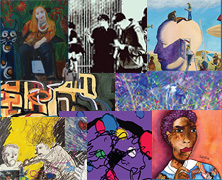Art Gallery
As part of this year's conference, we reached out to artists with disabilities and asked them to submit artwork connected to one or more knowledge translation topics. Some artists created new artwork, and others submitted existing artwork. Each artist submitted a statement that helps gallery attendees learn more about the artwork and how it relates to the knowledge translation topics. Artists also submitted photos and bios. The knowledge translation topics we presented to the artists were:
- Art as a powerful tool for sharing information with the disability community
- The importance of relationships in the exchange of information
- The need for more inclusive ways of generating and sharing research
- The importance of sharing research findings with people with disabilities
- The best ways to share research findings with people with disabilities
The Center on KTDRR is sharing these statements from the artists, and KTDRR staff made no edits to the text. In addition, after KTDRR staff recorded the descriptions artists submitted of their work, in some instances artists requested slight changes to the text. You may therefore notice slight differences between the written and audio descriptions.
Title of artwork: Portrait of Sue Elsegood
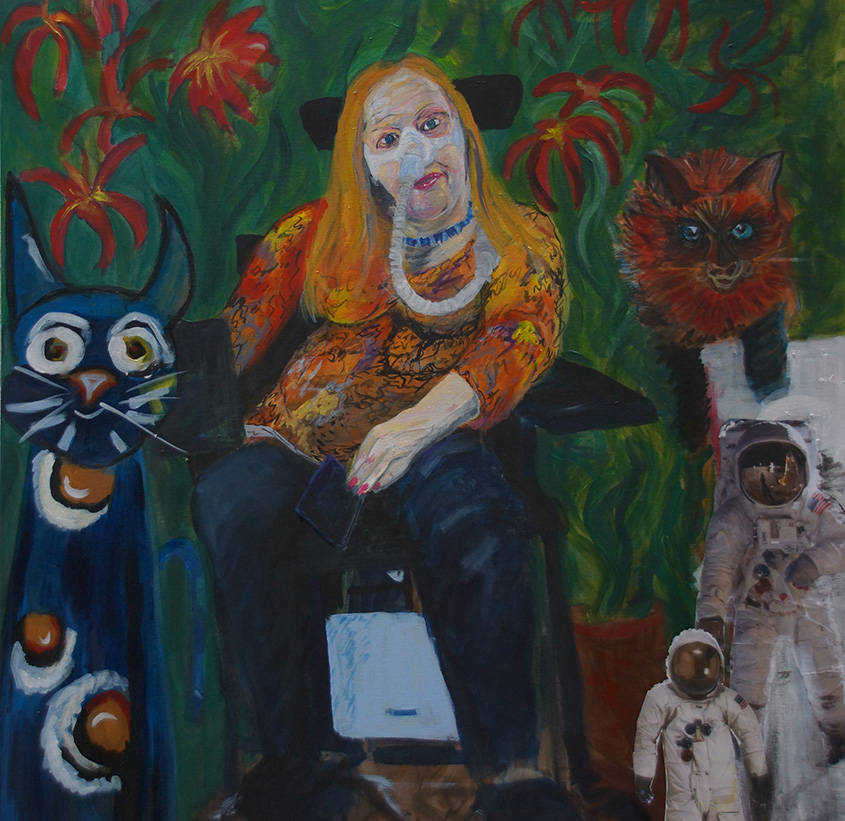
Artist: Michelle Baharier
Statement by the artist
Art as a powerful tool for sharing information with the disability community:
I paint pictures of many people in the disability community. The portraits I paint of people included people in wheelchairs and those with other visible and invisible disabilities. This painting is of Sue Elsegood, who chained herself to route master London double-decker buses and worked with other disabled activists to make public transport accessible for all. She worked tirelessly not out of choice but out of necessity. She said: ' they put a person the Moon, why cant a wheelchair user get on a bus@?The world does not realize that when you grow up with a disability you have to make changes in the world because the world does not meet your needs. So for example I am a multimedia visual artist, painter, photographer, and artist and performer, however, I face barrier after barrier to accessing things. The first barrier is always the written word, as my disability although invisible prohibits me from having access as written language is not my forte. I can not fill in forms and write applications without help.
The need for more inclusive ways of generating and sharing research:
How do you make research inclusive perhaps instead of using statistics and pie charts you use emojis.
The importance of sharing research findings with people with disabilities, including those from nondominant groups:
It is very difficult to know who is in a non-dom group, people with disabilities come from all echelons of society, across mainstream Society, and part of all classes, so ensuring that non-domin groups have access to information resources and research is crucial. But who decides who is non-dom as disabled people are part of all Different Class sections of society, and are all non-dom members of that community. How that happens requires investigations into where people live how people meet and how people access information.
The best ways to share research findings with people with disabilities, including those from nondominant groups:
I think sharing of research should be in mainstream media and should use such things as Facebook and Instagram however many known dominant groups may not use such forms of Media, and many disabled people may not use such forms of Media especially those with mental distress because the very means of mainstream Media can be distressing.
Visual description of the artwork
Click the hear the description read aloud.
Image of a woman sitting in a power chair with an orange shirt and black pants. She is wearing a mask over her nose attached to a gray tube. She sits next to a large, dark blue cat with brown and white spots. There are also astronauts and a dark brown cat with a large mane. The background is green with large yellow and red flowers.
Title of artwork: Fixing a Hole
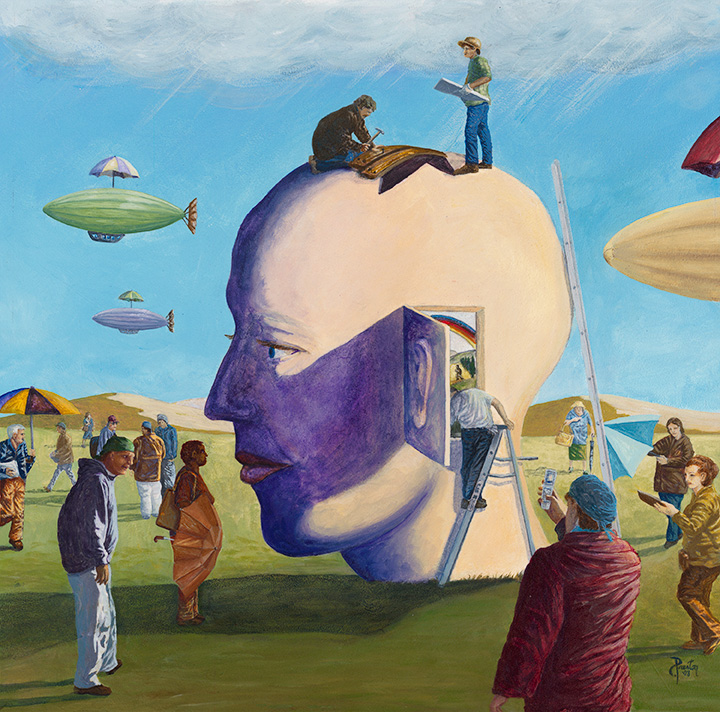
Artist: Preston Craig
Statement by the artist
Art is not only a powerful tool for communication between the artist and the viewer but also a way for the disabled to share information with the general public. Sometimes, that’s the only way one can communicate. Art also has the ability to visually share a message clearer than something that is written. Art is at times, visceral and the impact an image can have can sometimes be more expressive than a well-written document. The scene takes place in a park-like setting with dirigibles flying overhead. One can see people are speaking to each other, sharing their experiences or utilizing their phones or ipads to share information with others. Also, this shows the importance of relationships in the exchange of information, which are built on trust and openness. The central head figure is in the process of being repaired. Now, that could refer to an individual who is having difficulty communicating or sharing information. Someone who feels isolated in a crowd but with the right help or given the right information, they can be made whole.
Visual description of the artwork
Click the hear the description read aloud.
Image of a person’s head sitting in a grassy field with flying vehicles in the background with a blue sky and clouds. People in the field are looking at the head, taking pictures with their phones, covering parts of the head with building materials, and standing on a ladder to open parts of the head to “fix a hole.”
Title of artwork: Digital Boys
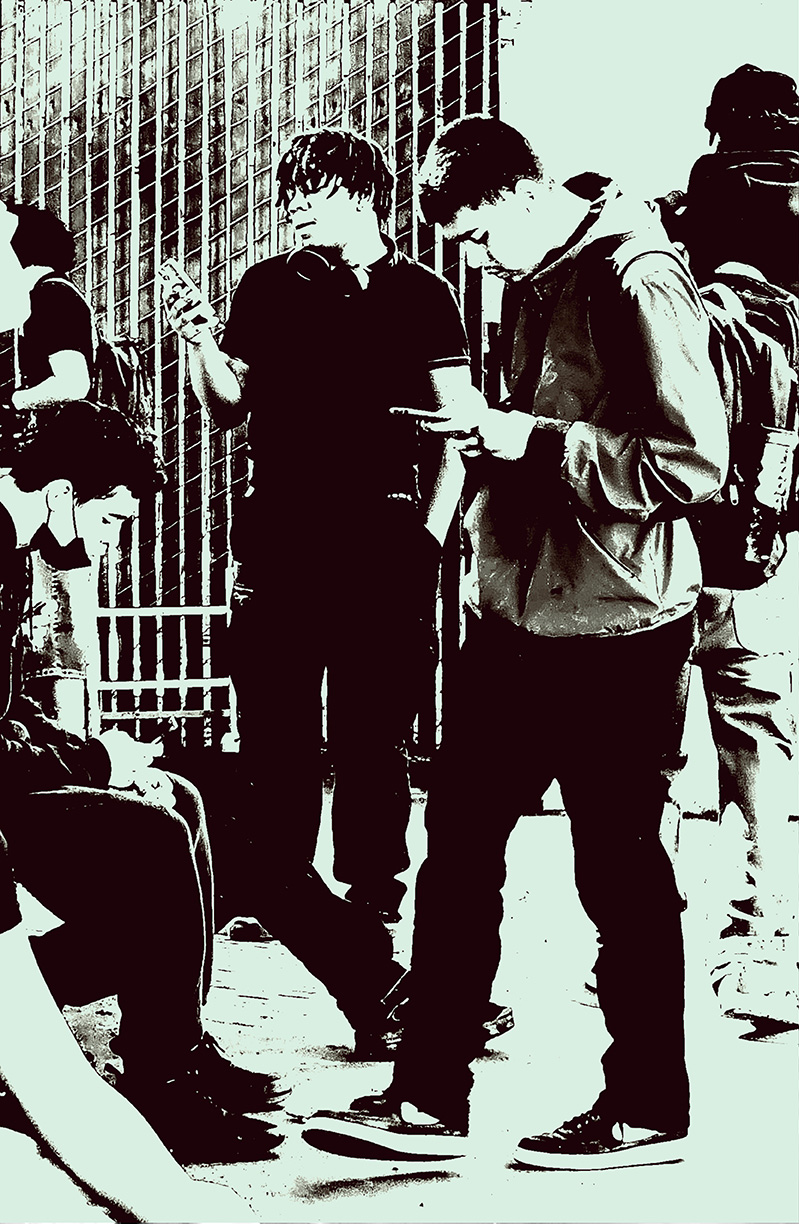
Artist: Moya Devine
Statement by the artist
The piece was taken at a public park; a public space.
The piece relates to these themes:
- The importance of relationships in the exchange of information
- The need for more inclusive ways of generating and sharing research
- The best ways to share research findings with people with disabilities, including those from nondominant groups
People are always on their phones and social networks have given rise to even more phone use. Social networks provide the individual a way to connect to other individuals and to groups they align with, virtually; in real time and asynchronistically (urban dictionary). These relationships have to an extent supplanted real time ones.
Somewhere between 86-92% of people own smartphones, and over 300 million people use social networks in the United States. When we take phone ownership and add it to the powerful tool of social media we have the perfect pathway to reach youth, non dominant groups and people with disabilities. These networks are based on relationships although non traditional ones.
By the nature of sheer numbers this is an excellent way to disseminate research and information. We just need to be highly discerning about what information is shared, the validity of the information and where the algorithms lead each social network participant.
Visual description of the artwork
Click the hear the description read aloud.
Photograph of three young men. Two of the men have short hair and one young man has braids past his eyes. The young men are all looking at their phones and wearing baggy clothes. One young man has a coffee and a backpack. They are in front of a large fence and the image is in black and white.
Title of artwork: Boundless
Click the play button to hear the original musical piece, Boundless.
Artist: Kelsey Dower
Statement by the artist
Art is a powerful tool, as it can be used for various purposes and the most powerful purposes are used for the following; to unite people in a common goal and to “force” people to truly see someone for more than who they present themselves to be. I wanted to make a song that didn’t just say “freedom”, but embodied it. Boundless has a message of not letting the limited mindset of others (peers, family, friends, professors, etc.) stop you from achieving the life you desire. I desire for the way that Boundless is composed, to embody the complexities of living as a neurodivergent person, and have a goal for Boundless to force potential ally’s to rise from the mindset of viewing non-neurotypical people as objects to dispose of when NT’s. It would be the most beneficial for ally’s and/or people who want to be ally’s to learn from the experiences of autistic people of intersecting identities that exist outside of eurocentric expectations of normality. Most people who diverge from colonizer-societal expectations are pre-conditioned to be in survival mode towards those who have no interest in being our ally. However, in the case of being an autistic person of color (especially autistic people of color who are women), we often feel as though we need to pick a battle to combat. The reality is, people with intersecting identities can’t just pick and choose a part of their identity to defend while just leaving other parts of themselves to just wait around to be taken care of. If one part of us is being discriminated against, then the rest of our identities are in just as much of an attack. To be an ally towards an autistic person of color, consider the following; take the professional advice of those who are strongly against curing autism and know that there’s no such thing or need, know the difference between showing no pity and showing no empathy, and that the world can have room for both neurotypical and neurodivergent blueprint to coexist and create/breed a less colonizer dependent society. As time goes on, society will change. Having a society that’s built around more neurodivergence won’t eradicate cruelty but will perhaps make more room for a breeding ground of a better mutual understanding of each other in a more general sense.
Visual description of the artwork
This artwork is a 4-minute symphonic metal musical performance. The music rises and falls with intensity and there are many instruments including piano, string instruments, and percussion. The artist intends for the music to “embody the complexities of living as a neurodivergent person.”
Title of artwork: Jayla
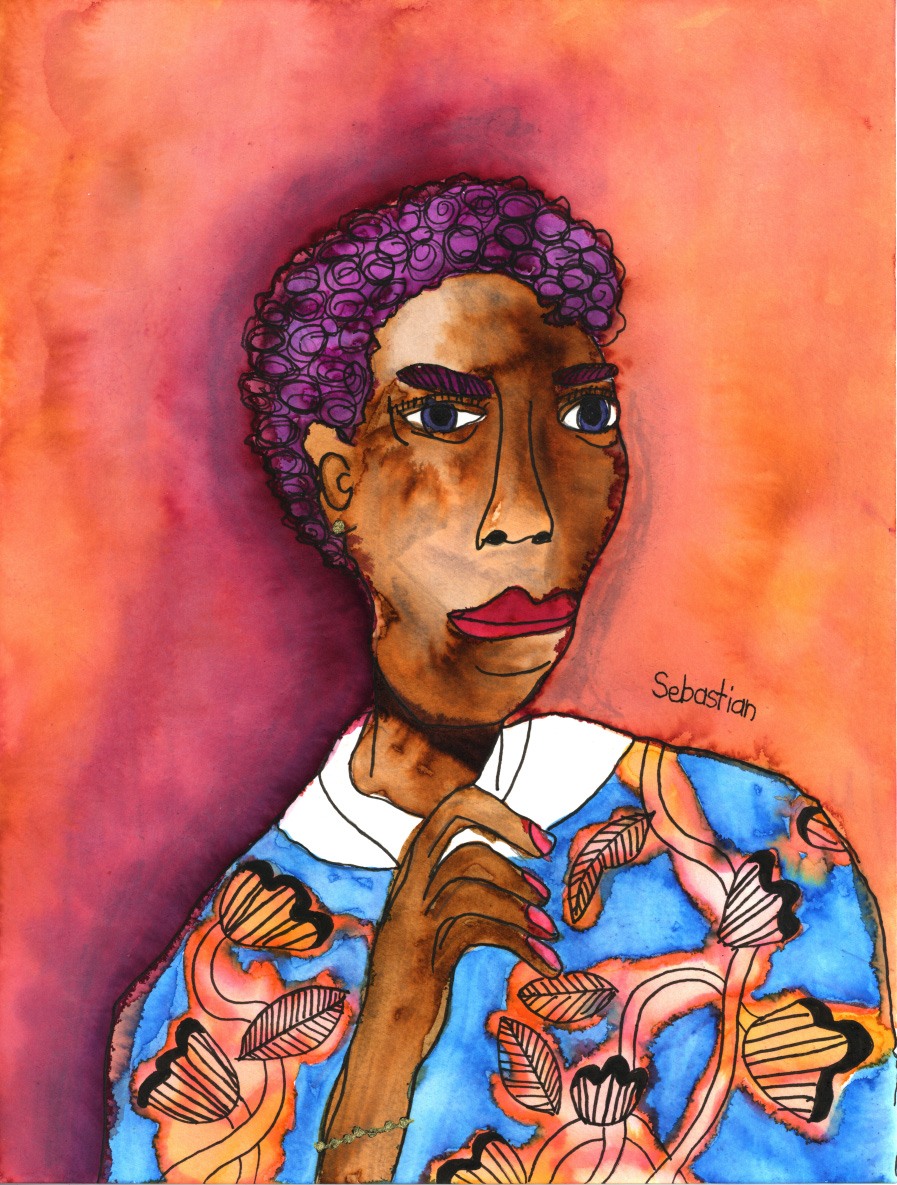
Artist: Sebastian Duverge
Statement by the artist
Jayla is the amazing woman smiling at the viewer. She has purple hair because she likes to stand out. She loves bold patterns. And she's proud of herself and the vibrant life she has built.
This woman is holding her hand up in confidence. She is ready to hear about the research that affects her. Jayla is smart, and she looks the researcher straight in the eye. As a Black, disabled person, she may be more marginalized than most. But she is eager to understand studies that include and affect her. She is a vital member of her community. She is powerful.
Visual description of the artwork
Click the hear the description read aloud.
Image of a powerful Black woman with short purple hair wearing a blue shirt with orange and black flowers. There is a sketch-like quality to the watercolor painting and many bright colors. The background is orange and pink.
Title of artwork: A Matter of Importance (Inner Dialogue)
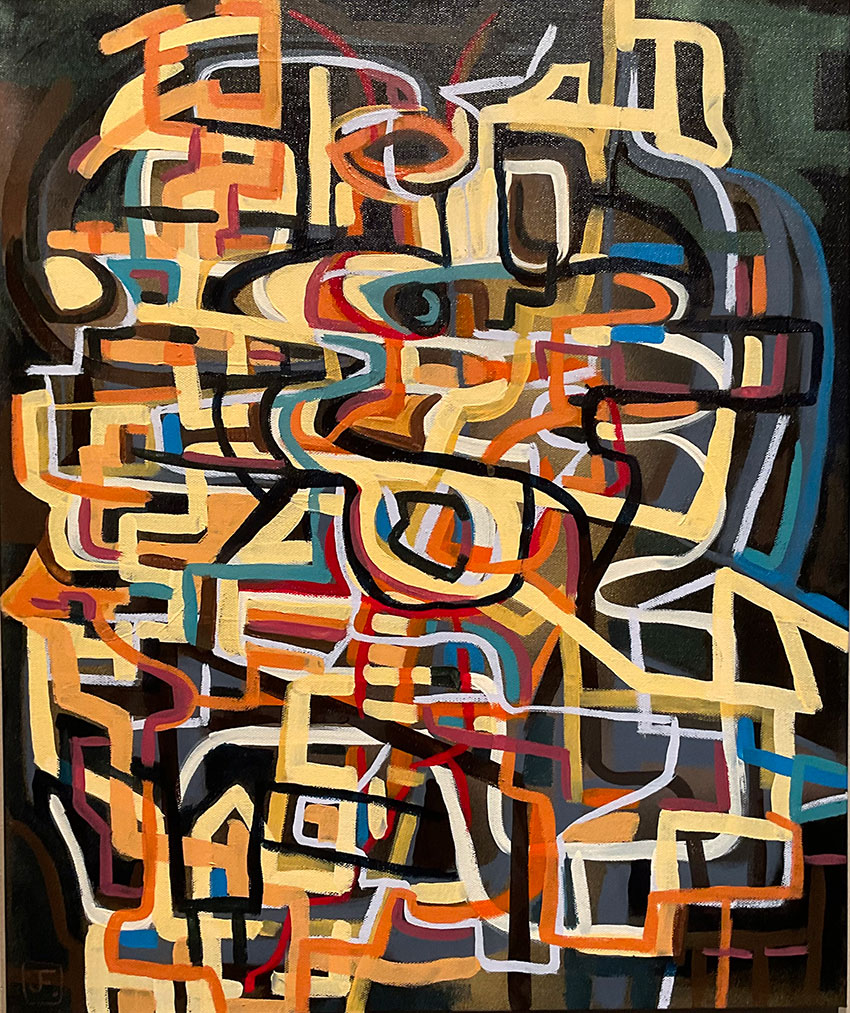
Artist: Joan Fabian
Statement by the artist
In this work I am conveying my thought processes, intuitive impulses and emotions in understanding my world. This is not a typical self-portrait but rather an investigation of the highways of communication between humans. There is so much inner traffic that is a dialogue between the Artist, self and the viewer. This investigation seeks to exhibit how complicated words, thoughts and assumptions make up the systems we use to understand one another. I would say that communication as an artist is two fold in that is is visual, like body language and like body language not everyone is attune to it as many do not pick up subtleties in the arts. It takes time and commitment to understand art.
1. Art as a powerful tool for sharing information with the disability
community.
Art for me has always been an inner dialogue and with this dialogue I
have sought out the silence to sort out and evaluate with my paint,
collage and digital mediums. I started as a small child making art to fill
up my world where I felt left out in the hearing world. I did not “see” that
I was different from all the other students learning in the classroom but I
was left out due to the culture of hearing and expectation that I was not
disabled and who I was with this silent disability. I believe making art
allowed me a sense of control where I did not have any yet wished to be
a valid and worthy individual who had something to contribute and
communicate. The isolation that continues in the art making profession
is necessary. The Art I make is not about being hard of hearing but
rather the cause of it.
2.The importance of relationships in the exchange of information
My art is better understood when a relation develops between the
viewer and the artwork. A common trigger of Art elements appeal to the
viewer, they are Individuals that are drawn to the work are naturally in
tune to gather more information to better understand my work. Like
getting to know a person. Thus a dialogue develops and a relationship
may develop, a patron maybe?
When people are relating there is an adjustment and familiarity that helps contribute to the exchange of information. The person understands I am an artist with a hearing impairment. The person may compare me to other artists with hearing impairments and/or artist that do not have hearing impairments. Is it important to avoid stereotyping in the communication exchange? I believe that a healthy relationship involves the acceptance of the art and artist as an individual, with unique disability traits. Every hearing impaired individual hears differently and has different ways of dealing with their impairments. In this way my painting discussed is an example of how complicated and intricate commication with another person can be.
In my painting there are marks like eyes that draw your attention similar where we focus on an individual in dialogue. The eyes of the viewer of the art are in constant motion absorbing all the visual clues quickly, and maybe become frustrated due to so much going on. Lines intersect and cross over and end and another line opens up. Do we see a head in motion? Did we miss some inner meaning or shall we make an assumption as to the meaning of all this chaos? My artist eyes seek out the expressions, clues and implications of sublities to make up for the commication I often miss when not hearing.
Visual description of the artwork
Click the hear the description read aloud.
Image of many overlapping lines criss-crossing a canvas. Some lines have sharp edges and some lines have soft edges. Most lines are yellow, orange, and black. Some lines are different shades of blue and white. The background is dark shades of brown and black.
Title of artwork: Better Git It Into Your Heart
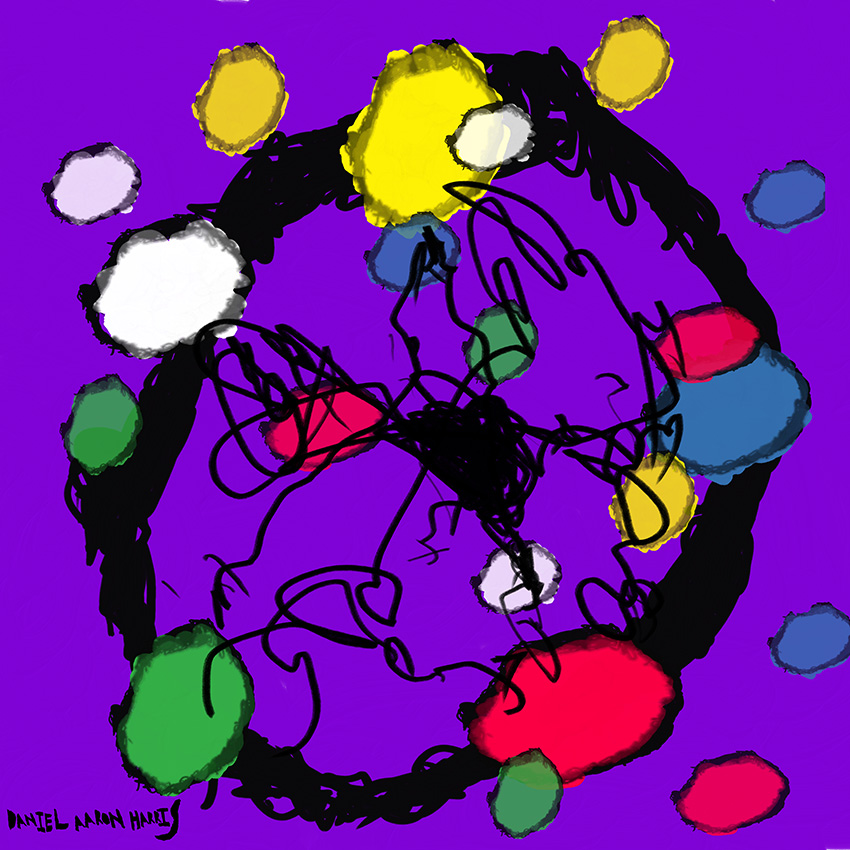
Artist: Daniel Harris
Statement by the artist
As a jazz fan, I wanted to use the composition Better Git It Into Your Soul by Charles Mingus, to influence the way i view disability and technology. We all have not only a seat at the table but an important voice. Using the colors of the disability flag I show that community is already there, influencing the “music”. We enter in and out at different times and together we dance together. That’s the essence of technology.
Visual description of the artwork
Click the hear the description read aloud.
Image of yellow, white, blue, green, and red dots connected by black squiggly lines in a circle. The black lines are connected at the center in a small cluster. The dots are different sizes and the background is purple.
Title of artwork: In My Lifetime
Artist: Keith Jones
Statement by the artist
In my lifetime is a small poetry piece with multimedia that helps us understand how America has changed over the last five decades. The piece reflects on the highs and lows of being an African-American male with a disability the United States.
Visual description of the artwork
In 1969, a mother gave birth to a little black boy in St. Louis, Missouri. Only five years after watching her family and the entire race of her people gained their civil rights. Only four years after that same group of people were given the right to vote.
By the time that child had reached the age of six. There were two things that happened. They repealed the ability to snatch their child from the streets under the pretenses of the ugly laws, while at the same time passing legislation for The Education for Handicapped Children in 1975.
This child playing with his cousins and his friends.
And not understanding that the reason every time he went to school, that all the kids looked like them was not because they had self-identified themselves as handicapped or different, was because the world had deemed them crippled.
It took another 15 years for that same act to be reauthorized and reinvested and renamed Individuals with Disabilities Education Act (IDEA). It was only another nine years after that with the Olmstead decision in which the Supreme Court said yes, that same black child who is now a black man has the right and the ability to live in his community.
Now, over the course of those 20 years up until 1999, the child had watched the absolute disinvestment of the inner city, the rebirth of the moral America, which had deemed those people who had just gotten their rights some 25, 26 years earlier, as not what America should represent.
How is this information pertinent?
This information is pertinent because those same sentiments and those same feelings are the same things that drive policy that have left children who look like that child who is now a man to say that:
We cannot get married.
We cannot be employed.
We cannot live on our own.
We cannot have families that look like us and represent our dreams and hopes that the American dream is supposed to represent.
Now understanding that he is only two generations removed from sharecropping. Three generations removed from emancipation. Four generations removed from chattel slavery.
And yet, that same little black boy that has turned into that black man still clings to the hope that those who are in this position will take it seriously that our humanity is more than our melanin content. More than our human condition that is often described as a disability, that we are more than the collective disregard for what we can't do. And that our excellence is not determined or defined by whether or not we can walk like everybody else. Like we can talk lie everybody else. Like we process information like everybody else.
The dream is to no longer to have to dream about what could be. The dream is that we finally find those folks who understand that casting our society and casting our humanity in the most negative light only lessons us all.
It is the elevation of understanding that beyond his melanin content, beyond his human condition, is the greatness that lies within all humans, to live and to breathe and to communicate and to contribute to a society in which greatness is displayed and is lived and is expressed and is enjoyed not because you are trying to prove that your humanity is valuable but because it is valuable.
Title of artwork: Neural Connection
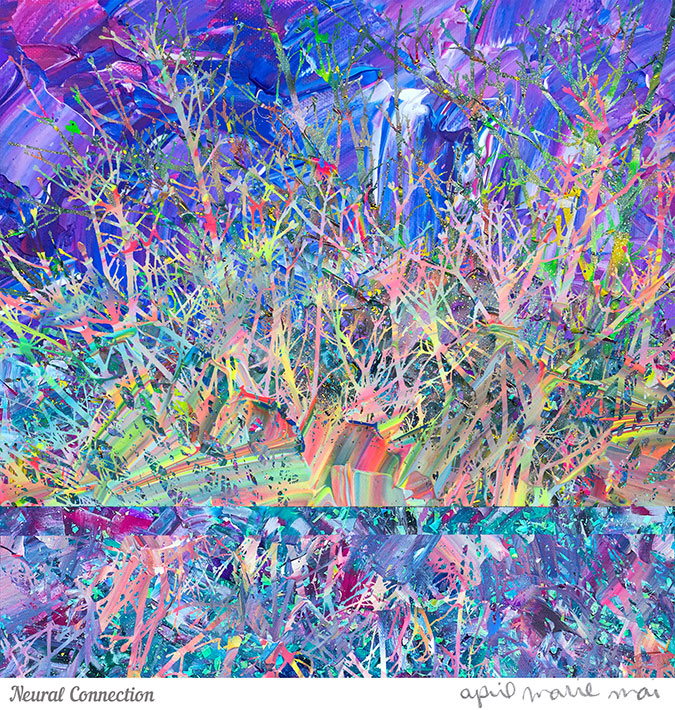
Artist: April Marie Mai
Statement by the artist
You can look at me from the outside and try to piece together your impression of what you think I might be feeling based on my movements and expressions, but it is always filtered through your idea of how the world has taught you to see me, not my actual experience. Because of this, researchers make a lot of incorrect assumptions about Disabled People’s experiences when we aren’t included in leadership in that research, and whole areas of study can be missed or come to erroneous conclusions.
As an Autistic person, researchers have often gotten it wrong, and even caused our deaths, because of the stories they have chosen to put to behaviors that are common for us. I want to live in a world where Autistic People aren’t being given electric shocks at voltages that can burn skin or make people unable to move because they are flapping their hands. They don’t have the ability to stand up for themselves, so the rest of us have to stand up for them, and try to stop it.
My nervous system rules my life. With other Autistic people, or with other people who live with fibromyalgia and constant migraines, there is a type of connection that usually contains more kindness, understanding, and accommodations than people who don’t live with these things are willing to give.
I created this artwork with that idea of neurons, mirroring, and a divide in understanding. Using my acrylic paintings and photographs I took of trees in the winter, I made a digital collage with tree branches reaching up like neurons…and a split…and others reaching down. What people see in others is often a reflection of how they view themselves, and it’s especially apparent as an Autistic Person that it plays a large role in research, premises, and in findings. If people just see in me all the things they have learned to demonize in society, they aren’t seeing me at all.
I hope to act as a bridge. Autistic and other Disabled traits should not be seen as making someone less than. I am not more human because I can make art and talk about it, or because I have a degree. I am as Autistic as they are. I have meltdowns and hit myself in the head, too. We are all different, and we have to see and accept all of that variety.
The vivid colors and patterns of my paintings that I used show how beautiful we all are. Unlike with my artwork, you can only see it if you make the effort to meaningfully include us.
Visual description of the artwork
Click the hear the description read aloud.
Image of long, skinny “neurons” that look like trees with many interconnected branches. The branches are very brightly colored with pink, purple, orange, pink, blue, and yellow. They appear fragile like glass. The bottom third of the image has neurons, or branches, going in different directions with a background that is darker than the top of the image, making it look like two separate pieces joined together.
Title of artwork: Rachel High interviews JulieMac in ‘Voices from The Knitting Circle’

Artist: Julie McNamara (a.k.a. JulieMc)
Statement by the artist
Art as a powerful tool for sharing information with the disability community.
How about we share our information with your academy? I can think of nothing more powerful than the voices of the Disability communities across the globe, speaking from lived experience to the academics and medics who are so wedded to studying and measuring our lives, to help us, to educate us, to mend our flawed bodies and imperfect minds. Documentary evidence speaks loud and clear in this image. NOTHING ABOUT US WITHOUT US!
The importance of relationships in the exchange of information.
This image speaks of the importance of changing the lead in conversations, expect the unexpected. Rachel High was the first person to tell me directly: 'I wish people would see past the Downs.'
I think this image speaks volumes about redistribution of the social contract - who's leading the conversation?
Visual description of the artwork
Click the hear the description read aloud.
This is a screenshot from the documentary 'Voices from The Knitting Circle' directed by JulieMac and produced by Vital Xposure, a Disability-led touring theatre based in London, capital of the Disunited Kingdom.
The splitscreen image has been carefully sized to mimic the feeding shutter in the doors of the old asylum / longcare hospital where residents of the Knitting Circle, referred to in the documentary, were committed.
We see an old style black and white image with two female characters framed in a split screen, as if they are gazing at each other in the same space. They are each set against an institutional white brick wall, framed to appear as if the two artists are meeting eye to eye, at the corner of two whitewashed walls. Overhead fluorescent lighting creates dramatic shadows over their faces. Rachel High, seated left as we look at the screen, is an artist with a recognizable learning disability. She is fair skinned, curvaceous with a sparkling necklace and carefully groomed curly hair. She sits confidently, staring openly at JulieMac, seated to the right. JulieMac is a tanned, androgynous person, dark short cropped hair and a dark V necked jumper. She is leaning against the wall, staring openly and leaning towards Rachel, with arms crossed and a slightly mischievous smile.
The caption beneath the image reads: Julie, tell me about The Knitting Circle?
Title of artwork: Pathways Paved by Chance
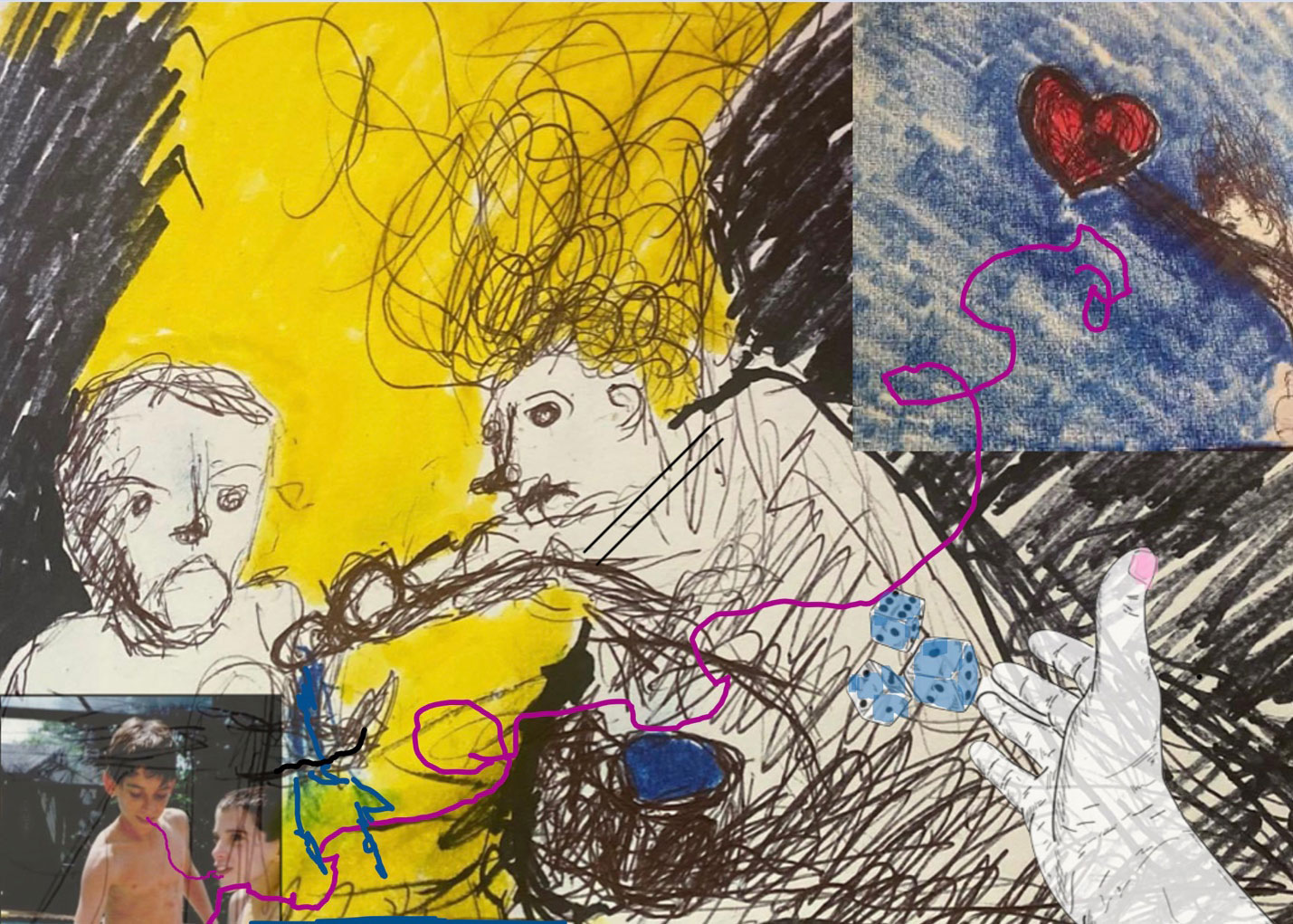
Artist: Christopher Worth
Statement by the artist
In participatory research, we create a situation where there is real opportunity to apply knowledge gained toward strengthening communities, lessening disparities, and really using research as a tool for liberation. This piece by Christopher R.J. Worth for him, examines a world where that participatory piece to thinking about research is left out for one participant and not for the other. Chris was born an identical twin. His identical twin Eric did not have the same experience that Chris had with connecting to researchers, building relationships, and then receiving interventions and therapies that came out of those relationships. Although the artist’s life was not easy by any stretch of the imagination, he credits his connection to places and people who applied thoughtful interventions to where he is today. Sadly, his brother, who did not receive the same attention, died this past year after years of abuse by others, abuse of himself, and neglect by systems. This piece talks about two twins’ lives, and how knowledge can be powerful enough to save lives and the lack of it can kill.
Visual description of the artwork
Click the hear the description read aloud.
This is a mixed media collage. Starting on the far left bottom corner, there is a picture of two bare chested boys, one is looking down at the other. They have a red mark running between their two mouths as if sharing it, or exchanging it with their mouths.
The purple mark then travels up from that visual element, looking like a string, it moves across the composition... behind it in the center of the composition but coming from the right, there is a ghost medicine person/witch, like figure, holding a spoon. The spoon drips with a blue liquid… the witch like figure is taking it from a bowl, at the front of the picture and he’s trying to feed it to another figure with a gaping mouth. The second figure has his hands outstretched, and some of the blue liquid pours through them. The witch/ghost figure, the spoon, and the gaping mouth figure are made of rough, deep, black pen marks.
Going back to the purple string, on the top right of the composition there is a figure holding a heart shape as though the figure is keeping it from floating away.
The purple string seems to have been at one time attached to the heart, but is now disconnected, and the string seems to be falling away from the heart. At the point where it might have been connected the string seems jumbled and falling. At the bottom right, the last visual element in the composition is an arm with a hand that is stark white with a pink thumbnail, which seems to be coming into the composition from somewhere else. The hand is throwing blue dice.

